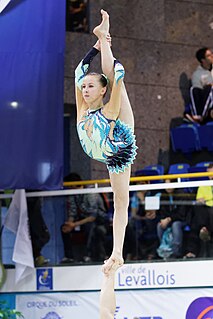
Gymnastics is a sport that includes physical exercises requiring balance, strength, flexibility, agility, coordination, and endurance. The movements involved in gymnastics contribute to the development of the arms, legs, shoulders, back, chest, and abdominal muscle groups. Alertness, precision, daring, self-confidence, and self-discipline are mental traits that can also be developed through gymnastics evolved from exercises used by the ancient Greeks that included skills for mounting and dismounting a horse and from circus performance skills.

The 1984 Summer Olympics, officially known as the Games of the XXIII Olympiad, was an international multi-sport event that was held from July 28 to August 12, 1984, in Los Angeles, California, United States. This was the second time that Los Angeles had hosted the Games, the first being in 1932. The United States won the medal count, winning the both the most gold medals and the most overall medals.

The 1932 Summer Olympics, officially known as the Games of the X Olympiad, was an international multi-sport event that was held from July 30 to August 14, 1932, in Los Angeles, California, United States.

The 1904 Summer Olympics, officially known as the Games of the III Olympiad, was an international multi-sport event which was celebrated in St. Louis, Missouri, United States from August 29 until September 3, 1904, as part of an extended sports program lasting from July 1 to November 23, 1904, located at what is now known as Francis Field on the campus of Washington University in St. Louis. It was the first time that the Olympic Games were held outside Europe.

Indian clubs, which originated in the Indian subcontinent, are a type of exercise equipment used to present resistance in movement to develop strength and mobility. They consist of bowling-pin shaped wooden clubs of varying sizes and weights, which are swung in certain patterns as part of a strength exercise program. They can range in weight from a few pounds each to special clubs that can weigh as much as up to 100 pounds. They were used in carefully choreographed routines in which the clubs were swung in unison by a group of exercisers, led by an instructor, similar to 21st-century aerobics or zumba classes. The routines would vary according to the group's ability along with the weights of the clubs being used. When the 19th-century British colonists came across exercising clubs in India, they named them Indian clubs.
At the 1932 Summer Olympics in Los Angeles, eleven events in gymnastics were contested. The competitions were held from Monday, August 8, 1932 to Friday, August 12, 1932.
The men's club swinging was an artistic gymnastics event held as part of the gymnastics at the 1904 Summer Olympics programme. It was the only time the club swinging event was held, though an "Indian clubs" competition was held at the 1932 Summer Olympics. An unknown number of gymnasts competed, only three are known. The competition was held on Friday, October 28, 1904.
Philip "Phil" Richard Erenberg is an American gymnast and Olympic medalist. He was Jewish. He competed at the 1932 Summer Olympics in Los Angeles where he received a silver medal in clubs.
William Kuhlemeier was an American gymnast and Olympic medalist. He competed at the 1932 Summer Olympics in Los Angeles where he received a bronze medal in clubs.
The men's parallel bars event was part of the gymnastics programme at the 1932 Summer Olympics. It was contested for the fifth time after 1896, 1904, 1924, and 1928. The competition was held on Friday, August 12, 1932. Fifteen gymnasts from six nations competed.
The men's rings or flying rings event was part of the gymnastics programme at the 1932 Summer Olympics. It was contested for the fifth time after 1896, 1904, 1924, and 1928. The competition was held on Friday, August 12, 1932. Fourteen gymnasts from six nations competed.
The men's pommel horse event was part of the gymnastics programme at the 1932 Summer Olympics. It was contested for the fifth time after 1896, 1904, 1924, and 1928. The competition was held on Thursday, August 11, 1932. Ten gymnasts from five nations competed.
The men's horizontal bar event was part of the gymnastics programme at the 1932 Summer Olympics. It was contested for the fifth time after 1896, 1904, 1924, and 1928. The competition was held on Thursday, August 11, 1932. Twelve gymnasts from six nations competed.
The men's vault or long horse vaulting event was part of the gymnastics programme at the 1932 Summer Olympics. It was contested for the fifth time after 1896, 1904, 1924, and 1928. The competition was held on Wednesday, August 10, 1932. Ten gymnasts from four nations competed.
The men's rope climbing event was part of the gymnastics programme at the 1932 Summer Olympics. It was contested for the fourth and last time after 1896, 1904, and 1924. The competition was held on Wednesday, August 10, 1932. Five gymnasts from two nations competed.
The men's tumbling event was part of the gymnastics program at the 1932 Summer Olympics. It was contested for the only time at the Olympics. The competition was held on Wednesday, August 10, 1932. Four gymnasts from two nations competed.
The men's floor or free-handed exercise event was part of the gymnastics programme at the 1932 Summer Olympics. It was contested for the first time at the Olympics. The competition was held on Monday, August 8, 1932. Twenty-five gymnasts from six nations competed.
The men's individual all-around event was part of the gymnastics programme at the 1932 Summer Olympics. It was the eighth appearance of the event, which was established in 1900. The competition was held from Monday, August 8, 1932, to Wednesday, August 10, 1932. Twenty-four gymnasts from five nations competed.
The men's team all-around event was part of the gymnastics programme at the 1932 Summer Olympics. It was the seventh appearance of the event, which was established in 1904. The competition was held from Monday, August 8, 1932, to Wednesday, August 10, 1932. Twenty-four gymnasts from five nations competed.





